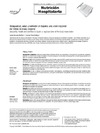Please use this identifier to cite or link to this item:
https://accedacris.ulpgc.es/jspui/handle/10553/73372
| Title: | Desigualdad, salud y nutrición en España: una visión regional del índice de masa corporal | Other Titles: | Inequality, health and nutrition in Spain: a regional view of the body mass index | Authors: | Aranceta Bartrina, Javier Perez Rodrigo, Carmen |
UNESCO Clasification: | 32 Ciencias médicas | Keywords: | Adultos Clase social Desigualdades Nivel educativo Obesidad |
Issue Date: | 2018 | Journal: | Nutrición Hospitalaria | Abstract: | Introducción y objetivos: numerosos determinantes ambientales influyen en el crecimiento y en el desarrollo y condicionan la expresión potencial o su evolución en el tiempo. Se analiza la influencia de algunos condicionantes sociodemográficos en la sobrecarga ponderal, en el peso y en la talla en la población adulta española. Métodos: el análisis se ha realizado en una submuestra (25 a 64 años) del estudio ENPE, estudio observacional transversal sobre una muestra poblacional aleatoria de población. Se recogió información sobre edad, género, nivel de estudios, ocupación y lugar de residencia. La clase social se codificó en función de la ocupación. Se tomaron mediciones individuales de peso y talla. Resultados: la prevalencia de obesidad es mayor en hombres, aumenta con la edad y se observa una relación inversa con el nivel de estudios y la clase social. Es mayor en Asturias, Galicia y Andalucía. La talla baja es más frecuente en personas con estudios primarios incompletos y clase social baja, al contrario que la talla alta, más frecuente también en las regiones norte-este y centro. El bajo peso corporal es menos frecuente en personas sin estudios y de clase social baja. Conclusiones: en base a la desigual distribución del sobrepeso y de la obesidad, las estrategias preventivas en nutrición comunitaria deben contemplar la mejora del nivel de educación nutricional y del grado de alfabetización de la población, con especial énfasis en las personas de entornos más desfavorecidos Background and objectives: a number of environmental determinants influence children growth and development and influence the potential expression or its evolution over time. In this paper we analyse the influence of selected sociodemographic factors on overweight, body weight and height in the Spanish adult population.Methods: the analysis was conducted in a subsample (25 to 64 years of age) of the ENPE study, a cross-sectional observational study on a random population sample. Information was collected on age, gender, educational level, occupation and place of residence. Social class was coded according to occupation. Individual body weight and height were measured.Results: the prevalence of obesity is higher in men, increases with age and there is an inverse relationship with the level of education and social class. Higher prevalence rates were observed in Asturias, Galicia and in Andalusia. Short stature is more frequent in people with incomplete primary education and low social class, in contrast to high stature, which is also more frequent in the North-East and central regions. Low body weight is less frequent in people with very poor education and low social class.Conclusions: based on the unequal distribution of overweight and obesity, preventive strategies in Community Nutrition should consider improving the level of nutrition education and literacy of the population, with special emphasis on the most disadvantaged people. |
URI: | https://accedacris.ulpgc.es/handle/10553/73372 | ISSN: | 0212-1611 | DOI: | 10.20960/nh.2096 | Source: | Nutricion Hospitalaria [ISSN 0212-1611], v. 35 (Extra 5), p. 142-149, (2018) |
| Appears in Collections: | Artículos |
WEB OF SCIENCETM
Citations
7
checked on Jun 8, 2025
Page view(s)
132
checked on Feb 1, 2025
Download(s)
114
checked on Feb 1, 2025
Google ScholarTM
Check
Altmetric
Share
Export metadata
Items in accedaCRIS are protected by copyright, with all rights reserved, unless otherwise indicated.
